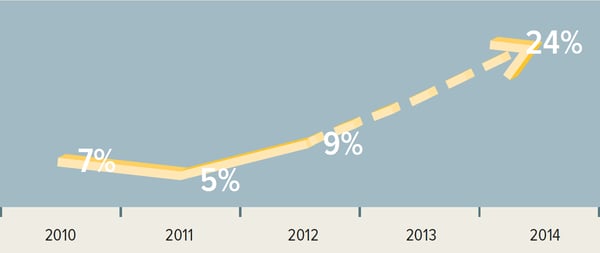
2016: the year of ‘impossible’ e-training? What does research say?
Geschreven door Marijn de Geus | January 26, 2016The rise of e-learning proved to be unstoppable in 2015. Even though the way of implementation differs between small and large organisations, we can see a growth that will persist. Concerning e-training, then: the online training of soft skills. How will this market behave in 2016? Will it shrink, stabilise or grow?
 Many Dutch organisations are still without e-training: almost 60%. However, this was even 73% in 2010, according to NIDAP. The Dutch market research bureau expects this ratio to change in the next few years, when only a minority of 40% will not use e-learning. This is supported by an impressive development of e-learning budgets in Dutch organisations with 100 or more employees:
Many Dutch organisations are still without e-training: almost 60%. However, this was even 73% in 2010, according to NIDAP. The Dutch market research bureau expects this ratio to change in the next few years, when only a minority of 40% will not use e-learning. This is supported by an impressive development of e-learning budgets in Dutch organisations with 100 or more employees:

Skills more important in larger organisations
Especially the smaller organisations (100-1000 employees) are maintaining classroom training worldwide, while 36% of organisations with more than 10.000 employees has already made the transition to online training, and another 25% are using blended learning. Bigger (Dutch) organisations are also taking the lead in training skills:

What many thought to be impossible
The fact that these developments coincide may be obvious for some TrainTool followers, but president of NIDAP Paul van der Wal emphasises this to be “what many thought to be impossible”. “Skills in the field of leadership, communication and sales by online learning. We’re seeing this in our own research, but fortunately also elsewhere: online learning used to be used especially in IT education, safety in the workplace and compliance, but now we are also seeing managers training leadership skills in this way. Large groups of salespersons, new call centre and front desk employees are following programmes dealing with communication skills and company induction in this way. Sometimes combined with face-to-face instruction or training.”
2016 will be the year of e-training, based on the worldwide growth rates of 7,9% for e-learning, 12,7% for mobile learning and 16,8% for simulation based e-learning. It is no longer a question of ‘will organisations make the transition?’, but ‘in what month will they start?’
Is your organisation ready to reap the benefits of e-training? Find out in a chat with one of our experts!



